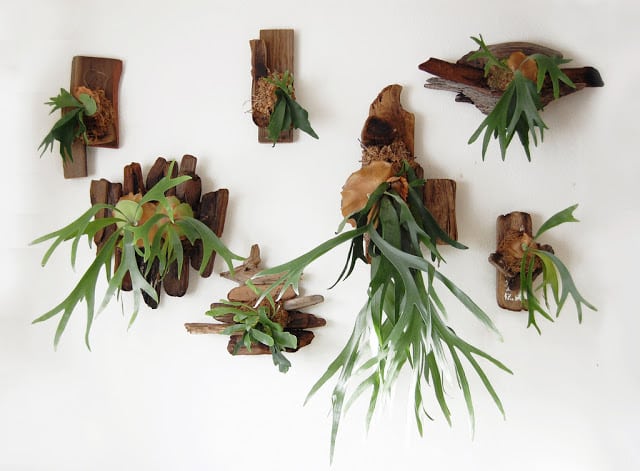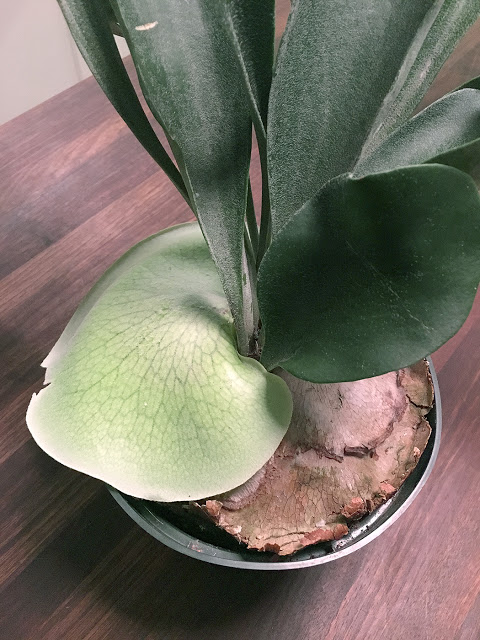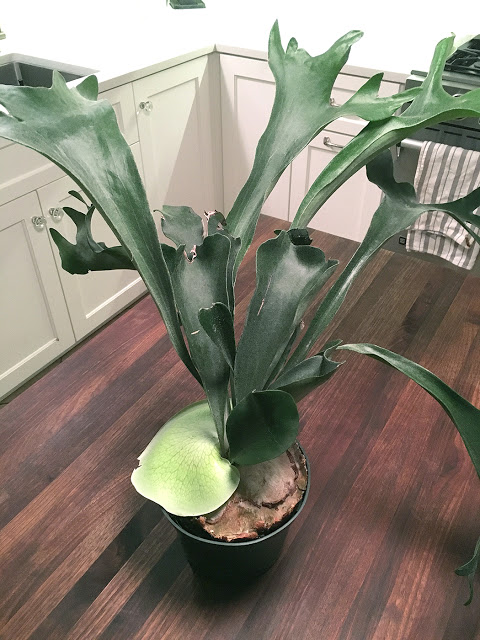 |
| Flora Grubb greenhouse photo |
For years I have wanted a staghorn fern (Platycerium bifurcatum). I think they are the coolest looking plants, with their big, strappy leaves that really do take on a very antlerlike look. But staghorn ferns are expensive and, I though, fussy. They want a moist atmosphere, which is not what my house offers in winter. They want spritzes and soaks and a little fertilizer.
But last year I happened upon a half-price houseplant sale at a nursery and found a small staghorn fern in a 6-inch pot for $5. How could I pass that up?
That was a year ago and that little staghorn has been doing great. It particularly loved its summer vacation outside and has been thriving since. I’ve done nothing to it other than running its fronds under water once every couple weeks and giving it a full-body soak every three to four weeks. Still, it has grown and has now put out a large sterile frond (the platelike bits at the base) that has far exceeded the rim of the pot and just keeps going.
As it turns out, that’s a sign that it’s time to get that baby out of its pot. It’s common to mount a staghorn fern on a board with a mound of spagnum moss under it (they are epiphytes so they don’t require soil) and then hang it on the wall. There are lots of tutorials out there about how to do this and I’ll save my opinions on them until I actually try it.
The care continues in the way: frequent misting (or at least some water on the fronds) and a good soak when it is completely dry. And this is where I have questions. Everything I’ve read suggests soaking the entire thing, including the board (which it is permanently mounted to until it outgrows that home). So I understand that you are to let it dry before you rehang it, but won’t the board still be wet when you do that (or at least damp)? How do you avoid damaging your walls?
If you grow staghorn ferns, I’d love to know how you manage this aspect. And I’ll take any other hints you have. I’ve become quite attached to this little guy.



9 Responses
Should I leave in put until it develops the sterile shield?
I love Staghorns! My husband takes care of a property and they have one…Hopefully I can get a pic of it posted. The owner has passed and thankfully the family let me get some cuttings. I pray the new owners love this big Stag as much as she did.
I have my staghorn mounted on a piece of cedar board. It has a cord attached to the board so I can move the fern to water it. I put it in my bathtub and turn on the shower for a few minutes and let it drain there for a while until it has drained well including the board and then hang it back up. It has tripled in size in less than a year.
Staghorns at least those commonly available as starter plants, (primarily P. Bifurcatum) do not require high humidity. They are however morphologically speaking different from what most are familiar with and this leads to many failures. Staghorns are very tolerant of dry periods and cannot tolerate being soggy. The sterile shield fronds that cover the plant base trap moisture. The most recent shields will be live and green slowly browning from the edges until the entire shield is brown. These dead shields are often 3/8″ thick around the growing center are sponge like, retaining significant water. Roots grow between the layered shields. Small plants have small shields and little distance from the growing center to the edge of the shield. This means that as the area around the plant dries there is little buffering. of the drying by shields. As the plant increases in size the area covered and the amount of spongy shield increases increasing the dry tolerance.
There are countless methods for creating vertical mounts and most should work. What often isn’t well addressed is that plants in pots don’t always show a clear top and bottom for mounting vertically and UPSIDE DOWN MOUNTS DIE. Fertile fronds and shields are produced at the base of the growth center in a staggered row left and right. All fronds originate in a vertical double row that resembles a closed zipper, (each frond base left and right is vertically 1/2 way between the two adjacent frond bases.) The tiny developing fronds continue this pattern decreasing in size until indistinguishable. This growth center must be above the fronds. When mounted upside down the growing eye will begin growing to one side in an effort to properly orient itself. Shield fronds produced under these conditions will twist as they develop covering the growing center preventing further growth and leading to death of the plant.
Erin, this is featured in our book, and I tell how to do it on my blog:
Staghorn Fern String Planter – DIY
The bathroom is a great place for a staghorn because of the humidity that occasionally occurs in that room.
I have had a staghorn fern for 15 years or so. It is huge now. I have never had luck with one on a board. I just left it in a planter as you have yours now. I put orchid medium in the pot. Just this year I had to split my staghorn. It is two huge pieces now. I have attached them to a limb of a tree that I put into a large pot. They look like a sculpture now.
Hey Lisa could you please share a photo of your stag horn fern. I’d really love to see how they look now in. A planter if you still have them
I've always loved these too, but like you never bought one. Looks like your stag horn is very happy! I'm interested to hear what your knowledgable readers say.
I've never grown a staghorn fern, although I nearly bought one a few weeks ago at a local nursery that had huge specimens for only $7. I did just tonight buy a blue star fern, but I think they need soil. Interesting — I'm looking forward to seeing how you handle this. Thanks for the houseplant info! -Beth